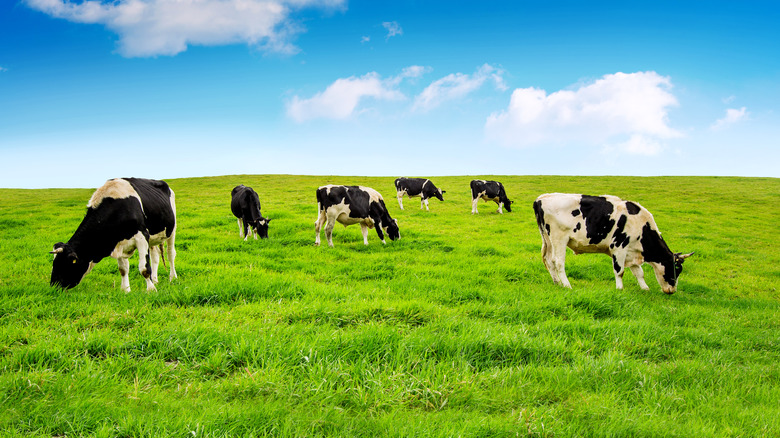The Scientific Reason Butter Is Yellow
According to the Los Angeles Times, in 2014 the U.S. hit a 40 year record high for butter consumption, consuming the most butter we'd consumed since the dawn of the fat-free era. And that was before butter boards, so one can just imagine what those numbers look like today. While Americans may have preferred cholesterol-free margarine for much of the 20th century, butter is back in a big way (per Food Network). Who would have ever thought that the hot hors d'oeuvre of the moment would be slathering butter on a piece of wood?
Butter has had a long and storied history, long before it graced the board. Did you know that humans have been making butter for over 10,000 years? That's right, the first butter was made by herders in Africa approximately 8,000 A.D. Of course, the first butters weren't from cows — they were sheep butter, and later yak butter and goat butter. But butter's still butter. A few thousand years later, butter was used as a beauty treatment to plump up the skin by the Ancient Egyptians and as a cosmetic by the Ancient Romans, who also applied the slick substance to wounds (per MPR News). But whether it was slathered on the skin like the ancients, or eaten like the really ancients, butter remained always that same creamy yellow substance we know and love. So, how come milk is white and butter is yellow?
Why is butter yellow? Beta-carotenes at play
Beta-carotenes play a large part in butter's yellow color. Cows absorb beta-carotenes, or natural yellow pigments, from grass they eat which then gets stored in their fat (per Herald-Tribune). This same beta-carotene is passed through into the fat globules in their milk. Milk has a relatively low fat percentage — we're talking, say, 3% for whole milk versus 80% for butter — which is part of why you may not notice much of a color difference, even in grass-fed milk.
Additionally, the fat globules in milk or cream are protected by a thin, light reflective membrane that makes the liquid appear white. The process of making butter — i.e. churning — aggressively breaks down that membrane, exposing the naked fat globules and their beta-carotene, thus becoming yellower as it churns (per Westgold).
But beware if you see "beta-carotene" listed as an ingredient in your butter. If that's the case, it's probably been added for color (per Insider). Since many commercial dairies don't allow their herds access to grass to eat, they have to find another way to make that butter yellow. Annatto, a substance derived from the seeds of the tropical achiote tree, is also used to make butter appear more yellow. You can avoid these additives by sticking to a good quality grass-fed butter, which may be better for your health anyway, as grass-fed butter is significantly higher in vitamin K, linoleic acid, and omega-3 fatty acids (per Healthline).

